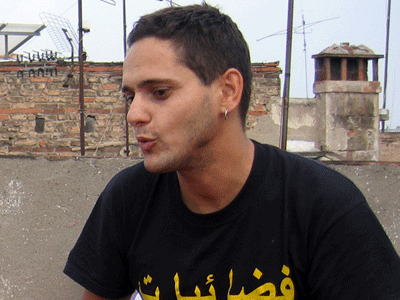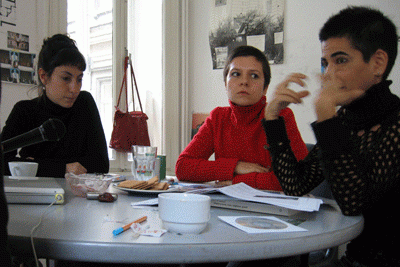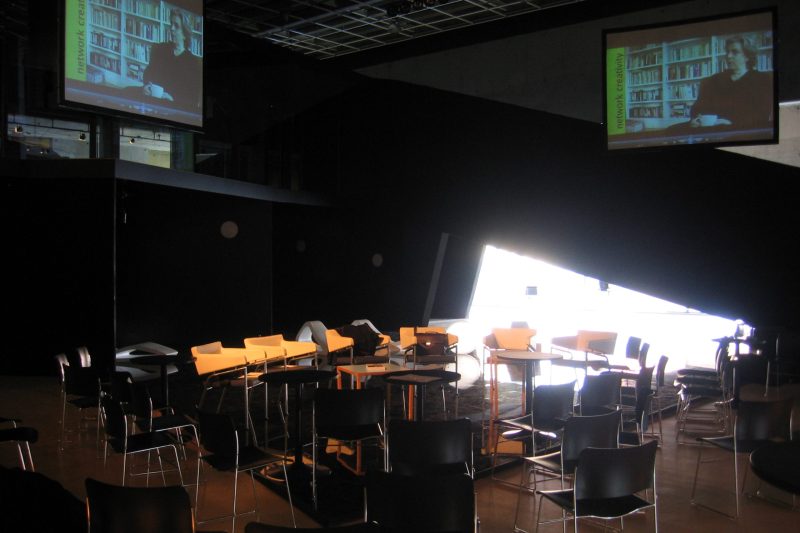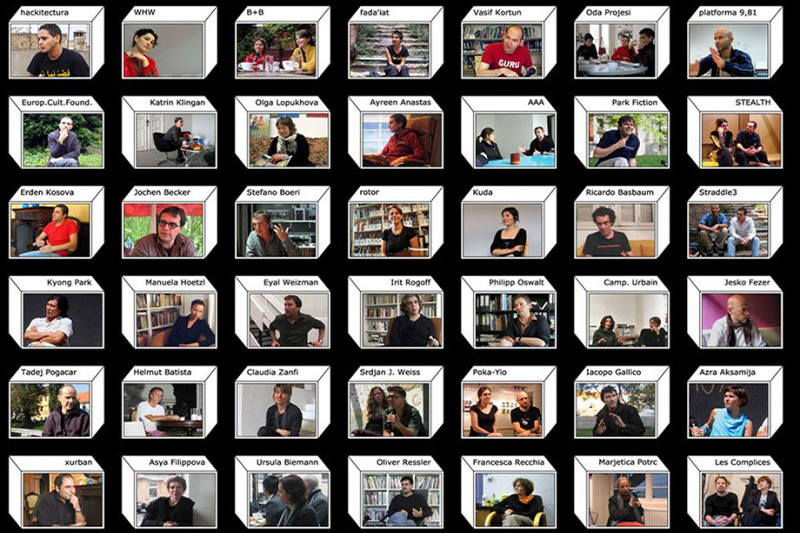- Interview
- Barcelona
- 2005
- NETWORKED CULTURES
CONVERSATION WITH PABLO DE SOTO
PM/HM: Hackitectura.net has produced a series of critical engagements related to how contemporary space is not only structured by physical buildings but also by electronic tools such as information networks, surveillance systems or tracking devices. How has this interest in the virtual led you to focus on border spaces?
Pablo de Soto: The beginning of hackitectura.net was related to our activities with the Internet and the desire to go beyond the idea of space as presented to us at architecture school. We thought a new world was emerging and no one at school was talking about it. From the start we wanted to try to experience some of the new aspects of telematic networks and figure out how to achieve different levels of presence. In 2002 we held a founding event: our idea involved going to a space and linking it to, let’s say, five or more different spaces in the world. At the time I had a filmmaker friend in Seville and I asked him if he was going to be working on a movie about Seville in the future, because we would like to provide a scene for it. In this scene, hackers would play a decision-making role in the city. The event was entitled Pure Data Beta Rave and its slogan was: “The world is interconnected, we cannot wait any longer!”
At the time, we weren’t just working locally with video and audio, but also with remote inputs. We talked with different groups, with people in Mexico, for example, who were organising the border hacking event in Tijuana in 2001. We learned a lot from them and we asked: do you want to tell people about your experiences via live streaming? More input arrived from Tarifa, Spain – from an activist reading a manifesto about new laws that discriminated against refugees. One year later we suggested the Indymedia Estrecho (Indymedia Straits) project. It was the seed of all that came afterwards.
This border in southwestern Europe is absolutely hard-core: it was militarised in 2002 when SIVE (a border surveillance system) began to be implemented. It consists of a network of sensors along the coast of Andalusia and the Canary Islands that are connected to an interception system. A new kind of control space has come into being; it’s not based only on physical but also on non-physical checkpoints that migrants sin papeles – without papers – can’t cross.
Within the context of the EU’s border management policy, the Spanish state has been a pioneer in this kind of electronic defence barrier. The United States built a wall along the Mexican border with equipment left over from the Gulf War (Operation Gatekeeper, 1994), but this wall went up in a, let’s say, more “post-modern” way: it’s an electronic wall that resembles medieval surveillance towers, yet also uses radar, infrared and optronic sensors. US and EU propaganda is selling the system to fight organised drug trafficking and people smuggling. But since SIVE has been in operation, boat people – who in the past crossed the Straits of Gibraltar where it was narrowest (between fourteen and forty kilometres) – have been forced to take much longer and more dangerous routes to avoid being tracked and intercepted. So here the rest of us are, living in wealthy Europe, often without any knowledge of the upgrades being made to this high-tech wall – the wall between us and the unfortunate people on the other side.
PM/HM: In contrast to these cases in which new technologies are implemented to secure the division of space, and separation of populations and cultures, hackitectura.net is working on strategies to develop subversive information networks that enable people to cross these divisions and connect different communities. What are the expectations linked to these counter-networks?
Pablo de Soto: As hackitectura.net, we were one of the founders of the Indymedia Estrecho project. It was launched in 2003 after a previously unsuccessful attempt to create a local Indymedia site in Seville. It happened within the scope of an activist and artist meeting in Andalusia to which UNIA – the International University of Andalusia – had invited us and other groups, artists and video-makers. We suggested using this gathering to start an experimental Indymedia Estrecho project. We weren’t alone in this process: people – mainly those who had been working with migrants for eights years already at the Casa de Iniciativas, a social centre occupied by squatters in Malaga – supported our independent media initiative. They had lots of grassroots know-how and practice with migration phenomena, so it was a very nice alliance.
At the beginning of the entire process there was an amazing discussion about whether we should focus on the Straits idea or create a more regional Andalusian Indymedia. We remarked that in this globalised world we have the choice, tactically speaking, to work from post-state identities. Capital is global and constantly relocating companies from here to there for cheaper labour (i.e., Spanish companies have moved maquilas to Morocco). When it comes to workers’ rights, you can fight for them in your neighbourhood, however, it might be more helpful to do so on both the local and global level. So if we want to change or to improve things at the southern European border, it’s not enough to do so merely from the perspective of a rather northern identity. The idea was to project our identity into the ocean, into the waters in between. From the ocean – and the idea of the Straits – we would be able to see north and south, up and down…
Right now there are nodes in several cities outside Andalusia, in northern Morocco, for instance, in Tangiers and Larache – but they aren’t very active. Though I can still say that at this very moment Indymedia Estrecho works as an information network and political platform for activists in the area; it promotes a previously non-existent Pan-Andalusian movement, as well as provides an information platform for people who want to know what is going on here: internauts from the United States, France, etc.
PM/HM: The Fada’íat project, with which you’ve been involved since 2004, intervenes in the contested realities of the Moroccan-Spanish border by setting up digital infrastructures and virtual networks, and thus connecting different localities to a global realm of information. What is your take on this intertwined engagement in physical and virtual space in relation to contemporary architectural practice?
Pablo de Soto: While architects once reacted to undefined border spaces by saying, “this is not for us”, we now see them as spaces where new struggles and revolutions are in progress. Actually we had wanted to be active in such a space from the beginning. In a way I think we decided to focus on this space and make it a long-term project after reflecting on the Zapatista movement, which has a twenty-five year history.
Following the Indymedia Estrecho project, Fada’íat was our next suggestion for interfering with the Spanish-Moroccan border. This project is about symbolically opening this cruel border and improving communication from bottom to top, and so generating critical output beyond what we hear in the corporate media about what is going on in this geographical region. In 2005, during an official summit between Spain and Morocco, three sub-Saharan migrants died at the border. The border police moved the bodies very quickly from one side to the other, i.e. they died on the Spanish side and were then transported to the Moroccan side. There’s a need to make this reality visible and to change how many see it: a low intensity war is going on at the border.
A new economy is emerging in relation to this militarisation. Within the EU’s border management policy, Spain is pioneering new means of controlling geographies. Such territorial control technology has also been sold to Greece and to Poland for its border with Belarus.
So hackitectura.net – with its platform for tactical cartography in 2003 and its Fada’íat laboratories from 2004 to the present – strives to do strategic work for this geography and its counter-geography, similar to what others have already done in Tijuana/San Diego or Israel. Our objective is to map the border as an economic and social space with its struggles and counter-hegemonic (or reality hacking) activities.

Pablo de Soto
is a researcher and practitioner in the fields of media architecture and social cybernetics. Together with chaser and osfa, he forms the core of Hackitectura, a collaborative network that conducts practical and theoretical research into the emerging territories of information and communication technologies, new social networks and traditional physical space. hackitectura.net has produced such events as La multitud conectada and Fada’iat. Pablo de Soto also promotes the Technology Observatory the Straits and co-edited the book Fada’iat: Freedom of Movement, Freedom of Knowledge. He co-curated ‘Emergent Geographies,’ the second edition of ‘Technology, Creativity and Society’ in Extremadura, and the project Situation Room at La LABoral. He holds a master’s degree in architecture from KTH Stockholm.


